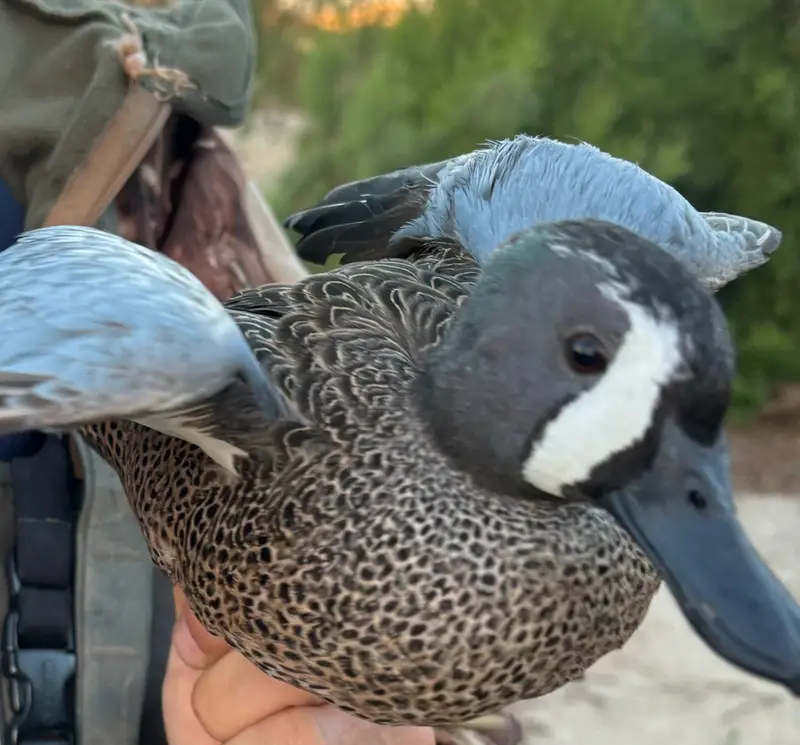About Blue-Winged Teal
Blue-winged Teal (spatula discors) , part of the dabbling duck family, are one of three teal varieties found in North America, alongside the Green-winged Teal (GWTE) and the Cinnamon Teal (CITE). BWTE are known for their long-distance migrations, remarkable agility, and the vibrant blue coloring on the drakes’ wings. Much smaller than many dabbling ducks, an adult will weigh 10-18 ounces. The prairie pothole region (PPR) is the heart of BWTE breeding grounds, serving as a crucial habitat. However, many teal can be seen on small farm ponds and “tanks” in agricultural land far south of the PPR, where they often spend the summer. This choice is partly because Blue-winged Teal require little water for breeding and will often halt at the first sign of suitable water on their northbound journey. This fact is reinforced by 50 Ducks‘ observation of two GPS-banded BWTEs. Neither of which migrated further north than Oklahoma. The onset of courtship among immature blue-winged teal often starts in late January or early February. In areas south of the breeding grounds, blue-winged teal are more active in courtship during the spring migration than many other duck species.
Blue-winged Teal are typically among the last dabbling ducks to nest, nesting mainly between April and May. This late nesting, in conjunction with being the first ducks to embark on the fall migration cycle, gives them a unique presence in their breeding grounds. BWTE are obligate migrants, which means their migration is driven by day length rather than weather or other external factors that might push waterfowl south. With our first GPS-tagged BWTE, we have observed migration feats such as: over 575 miles traveled in 11 hours, top speeds of 80MPH, and a maximum altitude of over 9,500 feet. Blue-winged teal generally lay around 10 eggs. Delayed nesting and renesting efforts after a failed first nest attempt generally result in smaller clutch sizes. Clutch size can also vary with the hen’s age, with yearlings tending to lay smaller clutches. Ducklings can generally walk to water within 12 hours and fledge after 5-7 weeks.

Identification
Blue-winged Teal are easily recognizable by the vibrant blue patches on the wings of drakes and their small size. Males also have a distinctive white crescent in front of their eyes, while females and juveniles are mottled brown with a subtle blue wing patch.
Breeding
Blue-winged Teal breed primarily in the prairie pothole region, however many breeding pairs can be found much further south, with nesting occurring between April and May. They prefer shallow wetlands with dense vegetation for nesting. Hens lay around 10 eggs per clutch, and ducklings are able to walk to water within 12 hours of hatching and fledge after 5-7 weeks.
Behavior
These teal are social and often form large flocks during migration and wintering periods. As dabbling ducks, they feed by tipping forward in shallow water to forage for seeds, and aquatic vegetation.
Habitat
During the breeding season, Blue-winged Teal inhabit shallow ponds, marshes, and wetlands in the northern prairies and boreal forests. In the winter, they can be found in a variety of wetland habitats, including estuaries, coastal marshes, and flooded fields. Their adaptability to different environments allows them to thrive across a wide range of habitats throughout their migratory range.
Migration
Blue-winged Teal are highly migratory, traveling from their breeding grounds in North America to wintering areas as far south as Central America. They are among the first ducks to migrate south in the fall and the last to return in the spring, with migration driven by day length rather than weather.
No Data Found
How many days tracked
Lorem ipsum dolor sit amet, consectetur adipiscing elit. Ut elit tellus, luctus nec ullamcorper mattis, pulvinar dapibus leo.
Where are they now?
Lorem ipsum dolor sit amet, consectetur adipiscing elit. Ut elit tellus, luctus nec ullamcorper mattis, pulvinar dapibus leo.
No Data Found
No Data Found
Total Number of Data Points for Blue-Winged Teal
Lorem ipsum dolor sit amet, consectetur adipiscing elit. Ut elit tellus, luctus nec ullamcorper mattis, pulvinar dapibus leo.
Start and End Date Tracking of Blue-Winged Teal
Lorem ipsum dolor sit amet, consectetur adipiscing elit. Ut elit tellus, luctus nec ullamcorper mattis, pulvinar dapibus leo.
No Data Found
Overall Data from the Center
This is historical data from various sources. This data is available in its full form on our Duck Map in an easily visualizable format.
